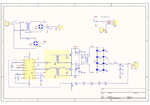arkanwe
Junior Member level 1
Hello, how are you?
I'm trying to design a high voltage power supply. It's the first SMPS I try to do. I've chosen a switching DC-DC converter,Half-Bridge, with the IC TL494 for control. The specifications are:
Vin = 311 V
Vout = 1 kV
Fsw = 55 kHz
Iout = 0.1 A
So far I came out with the following schematic,

The trouble is, how to drive the power mosfets?. I can't buy IC mosfet drivers, so it has to be with transformers.
I've seen circuits with many components on the gate side(R,C, & D), and different connections for the driver transformer side, with additional transistors.
The way it is I think it will either not switch, oscillate the gates, or make a short circuit on the mosfets. What do you think?
Can you recommend me what to do, schematic or book, to learn about this kind of problem?
It would be great to find some literature with a good explanation about this kind of problems, and topology.
Also, I'm missing line filter parts, over load protection, and maybe other important things, typical on ATX power supplys. But, I'm just starting with this, and only need a simple power supply working and reliable. Is there something really really important missing??
I didn't tested it as is yet, have fear to blow all up :-S
Many thanks in advance
I'm trying to design a high voltage power supply. It's the first SMPS I try to do. I've chosen a switching DC-DC converter,Half-Bridge, with the IC TL494 for control. The specifications are:
Vin = 311 V
Vout = 1 kV
Fsw = 55 kHz
Iout = 0.1 A
So far I came out with the following schematic,

The trouble is, how to drive the power mosfets?. I can't buy IC mosfet drivers, so it has to be with transformers.
I've seen circuits with many components on the gate side(R,C, & D), and different connections for the driver transformer side, with additional transistors.
The way it is I think it will either not switch, oscillate the gates, or make a short circuit on the mosfets. What do you think?
Can you recommend me what to do, schematic or book, to learn about this kind of problem?
It would be great to find some literature with a good explanation about this kind of problems, and topology.
Also, I'm missing line filter parts, over load protection, and maybe other important things, typical on ATX power supplys. But, I'm just starting with this, and only need a simple power supply working and reliable. Is there something really really important missing??
I didn't tested it as is yet, have fear to blow all up :-S
Many thanks in advance